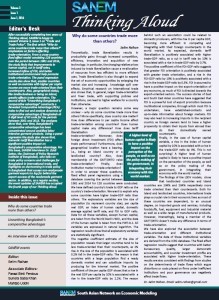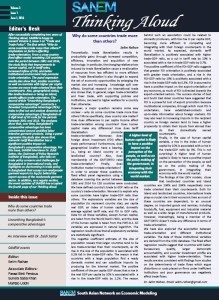
Thinking Aloud: Volume III, Issue 1
 After successfully completing two years of Thinking Aloud, SANEM is happy to present the Volume 3, Issue 1 on “Trade and Trade Policy”. The first article “Why do some countries trade more than others?” emphasizes on factors affecting the trade-orientation. From a cross-country fixed effect model consisting 128 countries over the period between 1981 and 2014, the study finds that improvements in human capital, cut in tariff rates, increased inflow of FDI, and better institutional environment help promote trade-orientation. The panel regression results also show that, smaller countries as well as countries with higher per capita income are more trade-oriented than their counterparts. Also, geographical status, like landlockedness or being an island, greatly affects trade-orientation. The second article “Unearthing Bangladesh’s comparative advantage” constructs Revealed Comparative Advantage (RCA) index to find out and analyze dynamics of comparative advantage of Bangladesh at 6 digit level of HS code for the periods between 2001 and 2013. The analyses show that, over the time, Bangladesh’s comparative advantage has been concentrated around unskilled labor intensive garment products. Using a panel regression the study also shows that, domestic tariff liberalization has a significant positive impact on Bangladesh’s comparative advantage. For this issue, SANEM interviews Dr. Zaidi Sattar, the Chairman of the Policy Research institute of Bangladesh, who talks on trade policy concerns and challenges for Bangladesh in international trade, and highlights on shortcoming in trade policy in Bangladesh that causes non-readymade garment exports to lag far behind the export success of the readymade garment sector. In addition, as a regular section, the event updates of SANEM has occupied the fourth page of our Thinking Aloud.
After successfully completing two years of Thinking Aloud, SANEM is happy to present the Volume 3, Issue 1 on “Trade and Trade Policy”. The first article “Why do some countries trade more than others?” emphasizes on factors affecting the trade-orientation. From a cross-country fixed effect model consisting 128 countries over the period between 1981 and 2014, the study finds that improvements in human capital, cut in tariff rates, increased inflow of FDI, and better institutional environment help promote trade-orientation. The panel regression results also show that, smaller countries as well as countries with higher per capita income are more trade-oriented than their counterparts. Also, geographical status, like landlockedness or being an island, greatly affects trade-orientation. The second article “Unearthing Bangladesh’s comparative advantage” constructs Revealed Comparative Advantage (RCA) index to find out and analyze dynamics of comparative advantage of Bangladesh at 6 digit level of HS code for the periods between 2001 and 2013. The analyses show that, over the time, Bangladesh’s comparative advantage has been concentrated around unskilled labor intensive garment products. Using a panel regression the study also shows that, domestic tariff liberalization has a significant positive impact on Bangladesh’s comparative advantage. For this issue, SANEM interviews Dr. Zaidi Sattar, the Chairman of the Policy Research institute of Bangladesh, who talks on trade policy concerns and challenges for Bangladesh in international trade, and highlights on shortcoming in trade policy in Bangladesh that causes non-readymade garment exports to lag far behind the export success of the readymade garment sector. In addition, as a regular section, the event updates of SANEM has occupied the fourth page of our Thinking Aloud.
.
Link:Thinking-Aloud_V3_N1
Tag: Trade policy, comparative advantage



